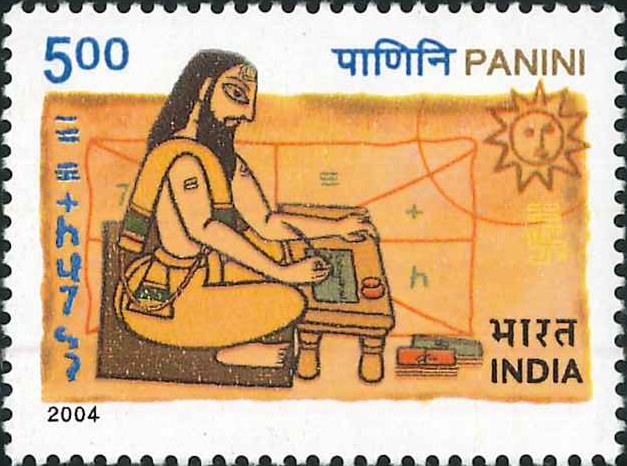
Panini
A commemorative postage stamp on Daksiputra Pāṇini, an Sanskrit grammarian, considered as father of computing machines :

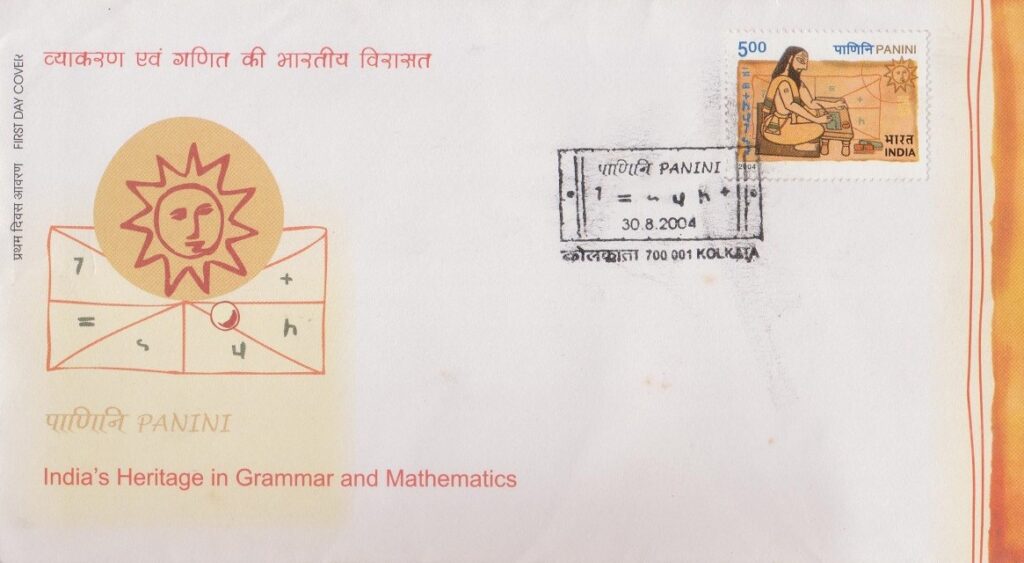 Issued by India
Issued by India
Issued on Aug 30, 2004
Issued for : The Department of Posts is proud to issue a commemorative postage stamp on this colossus whose work is regarded as one of the greatest monuments of human intelligence.
Credits :
Stamp & FDC : Kamleshwar Singh
Cancellation : Alka Sharma
Type : Stamp, Mint Condition
Colour : Multicolour
Denomination : 500 Paise
Print Quantity : 0.4 Million
Printing Process : Photogravure
Printer : India Security Press, Nashik
About :
- India’s contribution to the scientific, technological, literary and mathematical advancements of the world is undeniably monumental. Beginning with the Indus Valley Civilisation through the Vedic and Mauryan ages to the Golden Age of Indian Culture during the Gupta period, Indian scholars capitalised on the patronage extended to them and carved out an environment that was conducive to intensive research and a vigorously brilliant outburst of knowledge and learning. A particularly important development in the history of science in India was influenced by the accomplishments of Panini, one of the greatest grammarians of all time whose work revolutionised the use of language not only in India but also in the rest of the world.
- Panini was born in Shalatula, a town near Taxila on the Indus River in the present-day North-West Province in Pakistan. The dates given for Panini’s birth range from the Fourth to the Seventh Century BC. However, it is believed that he was born about 520 BC and died about 460 BC. His mother Dakshi and father Pani initiated him into the worship of Lord Shiva and tradition has it that the Lord himself revealed the form of grammar through the sound of his drum – those intricate formulaic Shiva Sutras that initiated unfolding of complex structures.
- The word ‘Sanskrit’ means ‘complete’ or ‘perfect’ and Sanskrit was not only the classical literary language of the Indian Hindus, it was also thought of as the divine language or language of the Gods. Panini’s brilliant account of the structure of the Sanskrit language seeks to provide a complete, maximally concise and theoretically consistent analysis. It unfolds a theory of human language where the infinite language is generated by a finite grammar which modern linguistics acknowledges as the complete, generative grammar of any language yet written.
- Panini’s comprehensive theory of the phonetics, phonology and morphology of Sanskrit language relies on patterns found in the language. Features of language are categorised according to their similarities and then form the subject matter of the set of ordered morphological rules which constitute the bulk of the work. Inherent in the analytic approach employed by Panini are the concepts of phoneme and morpheme. Paninian grammar is notably descriptive, it does not attempt to tell people what they should speak and write but what people actually did say and write.
- Panini gives formal production rules and definitions to describe Sanskrit grammar. There are four major components of his grammar: (i) ‘Astadhyayi’ or ‘Astaka’ which is Panini’s major work of eight chapters, each subdivided into quarter chapters; it is an ordered system of around 4000 rules formulated in the Sutra form, remarkable for their brevity and charity; (ii) ‘Sivasutras’ which are classes of phonological segments, which allow for statements on processes in the sound system to be made in a natural way. (iii) ‘Dhatupatha’ a list of about 2000 verbal roots, with sub classification and diacritic markers encoding morphological and syntactic properties, (iv) ‘Ganapatha’ classes of lexical items idiosyncratically subject to various rules. While none of the components is intelligible in isolation, together they constitute a complete integrated system of grammar.
- Today, Panini’s grammar has been compared to Euclid’s geometry and his constructions can be seen as comparable to modern definitions of a mathematical function. G.G. Joseph, a renowned mathematician argues in ‘The Crest of the Peacock’ that the algebraic nature of Indian mathematics arises as a consequence of the structure of the Sanskrit language. In particular, he suggests that algebraic reasoning, the Indian way of representing numbers by words, and ultimately the development of modern number systems in India, are linked through the structure of language. Thus, Panini’s work provided an example of a scientific notational model that could have propelled later mathematicians to use abstract notations in characterising algebraic equations and presenting algebraic theorems and results in a scientific format.
- Panini’s rules are said to be perfect – that is, they perfectly describe the Sanskrit morphology, and are regarded as so clear that computer scientists have made use of them to teach computers to understand Sanskrit. Panini uses metarules, transformations, and recursion in such sophistication that his grammar has the computing power equivalent to a Turing machine. In this sense Panini may be considered the father of computing machines. As such Panini should be thought of as the forerunner of the modern formal language theory used to specify computer languages. It is remarkable that concepts, which are fundamental to today’s theoretical computer science, should have their origin with an Indian genius around 2500 years ago.


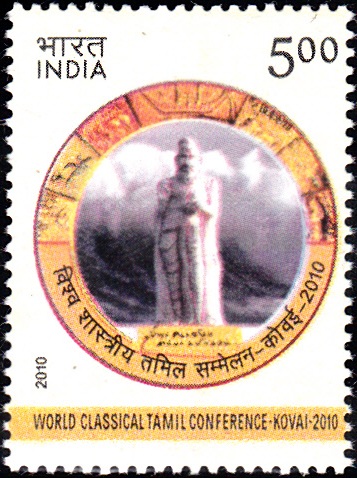
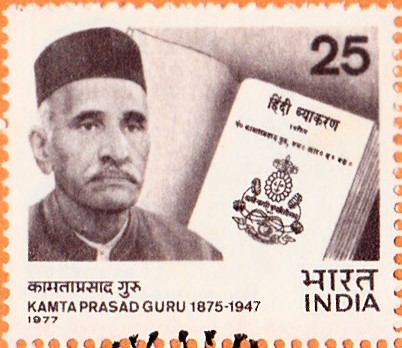

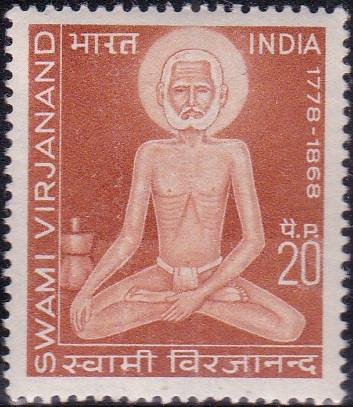
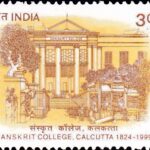
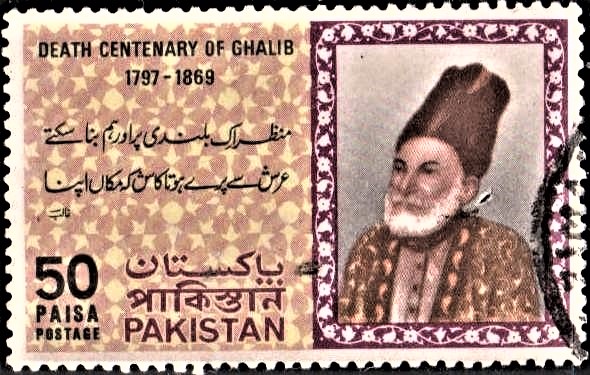
I want buy ur site
[…] of social-cultural activity. Ancient universities like Taxila and Nalanda produced luminaries like Panini, Kautilya and Charaka and imparted education in a wide range of subjects including logic, grammar, […]
[…] of social-cultural activity. Ancient universities like Taxila and Nalanda produced luminaries like Panini, Kautilya and Charaka and imparted education in a wide range of subjects including logic, grammar, […]
[…] composition of Vedas which contains a lot of Tamil words in it. Kaatyayana who paraphrased Panini‘s grammar called Astadhyaayi and Patanjali said that they were seen to be proficient in […]
[…] mostly Bengali translations of renowned Sanskrit texts like popularised and simplified the study of Sanskrit Grammar by the literary world rightly entitled him to be called one of the fathers of modern Bengali […]
[…] Ram Dhekial Phukan described as Raja Ram Mohan Roy of Assam, Hem Chandra Barua recognised as the Panini of Assamese language and Gunabhi Ram Barua eulogised as the Vidyasagar of Assam started their […]